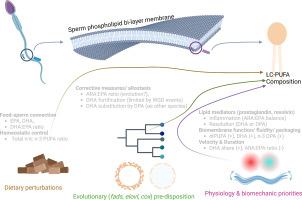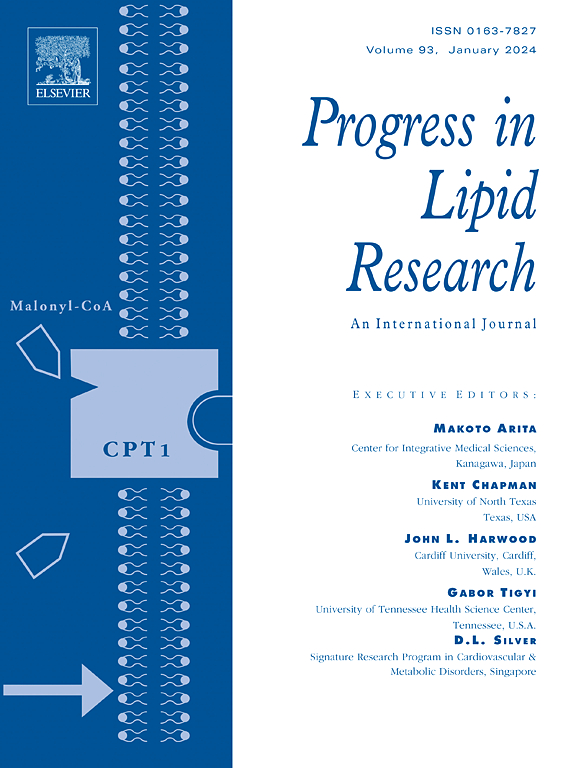Long chain polyunsaturated fatty acid (LC-PUFA) composition of fish sperm: nexus of dietary, evolutionary, and biomechanical drivers
IF 14
1区 医学
Q1 BIOCHEMISTRY & MOLECULAR BIOLOGY
引用次数: 0
Abstract
Long-chain polyunsaturated fatty acids (LC-PUFA) like arachidonic acid (ARA, 20:4n-6), eicosapentaenoic acid (EPA, 20:5n-3), and docosahexaenoic acid (DHA, 22:6n-3) constitute one-third to half of fish sperm lipids. Fish sperm is rich in phospholipid (PL)—primarily phosphatidylcholine, phosphatidylethanolamine, and sphingomyelin. DHA is generally the most abundant LC-PUFA in each PL class, followed by competition between ARA and EPA. While the total n-6: n-3 PUFA ratio does not correlate significantly with sperm biomechanics, LC-PUFA do. DHA positively influences sperm biomechanics, while ARA and EPA may be negatively associated. Fish sperm maintains lower (≤1) total n-6 PUFA per unit of n-3 PUFA but keep a higher (>1) ARA per unit EPA. A weak dietary influence on sperm EPA and DHA exists but not on ARA. The DHA: EPA ratio in fish sperm is often >1, though values <1 occur. Certain species cannot fortify DHA sufficiently during spermatogenesis, diverging through whole genome duplications. Fish sperm can show ARA: EPA ratios greater or less than 1, due to shifts in prostaglandin pathways in different evolutionary eras. DHA-rich PL bilayers provide unique packing and fusogenic properties, with ARA/EPA-derived eicosanoids guiding sperm rheotaxis/chemotaxis, modulated by DHA-derived resolvins. Docosapentaenoic acid (DPA, 22:5n-3) sometimes substitutes for DHA in fish sperm.

鱼类精子的长链多不饱和脂肪酸(LC-PUFA)组成:膳食、进化和生物力学驱动因素的联系。
花生四烯酸(ARA,20:4n-6)、二十碳五烯酸(EPA,20:5n-3)和二十二碳六烯酸(DHA,22:6n-3)等长链多不饱和脂肪酸(LC-PUFA)占鱼类精子脂质的三分之一到一半。鱼类精子富含磷脂(PL)--主要是磷脂酰胆碱、磷脂酰乙醇胺和鞘磷脂。DHA 通常是每类磷脂中含量最高的 LC-PUFA,其次是 ARA 和 EPA。虽然 n-6: n-3 PUFA 的总比例与精子的生物力学没有显著相关性,但 LC-PUFA 与精子的生物力学有显著相关性。DHA 对精子的生物力学有积极影响,而 ARA 和 EPA 则可能有消极影响。鱼类精子中每单位 n-3 PUFA 的 n-6 PUFA 总含量较低(≤1),但每单位 EPA 的 ARA 含量较高(>1)。膳食对精子中的 EPA 和 DHA 有微弱的影响,但对 ARA 没有影响。鱼类精子中 DHA 与 EPA 的比率通常大于 1,尽管其值为 1。
本文章由计算机程序翻译,如有差异,请以英文原文为准。
求助全文
约1分钟内获得全文
求助全文
来源期刊

Progress in lipid research
生物-生化与分子生物学
CiteScore
24.50
自引率
2.20%
发文量
37
审稿时长
14.6 weeks
期刊介绍:
The significance of lipids as a fundamental category of biological compounds has been widely acknowledged. The utilization of our understanding in the fields of biochemistry, chemistry, and physiology of lipids has continued to grow in biotechnology, the fats and oils industry, and medicine. Moreover, new aspects such as lipid biophysics, particularly related to membranes and lipoproteins, as well as basic research and applications of liposomes, have emerged. To keep up with these advancements, there is a need for a journal that can evaluate recent progress in specific areas and provide a historical perspective on current research. Progress in Lipid Research serves this purpose.
 求助内容:
求助内容: 应助结果提醒方式:
应助结果提醒方式:


